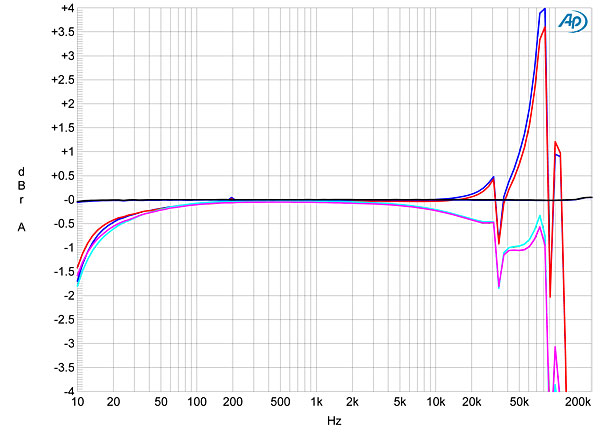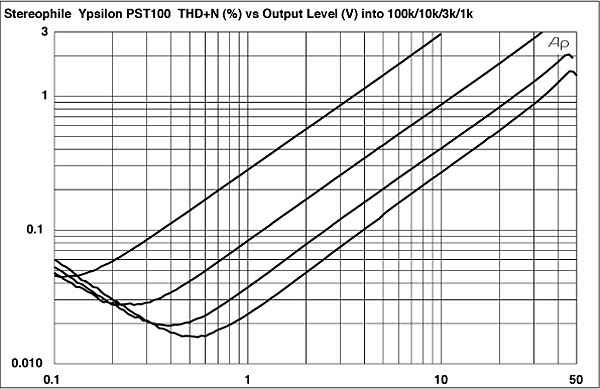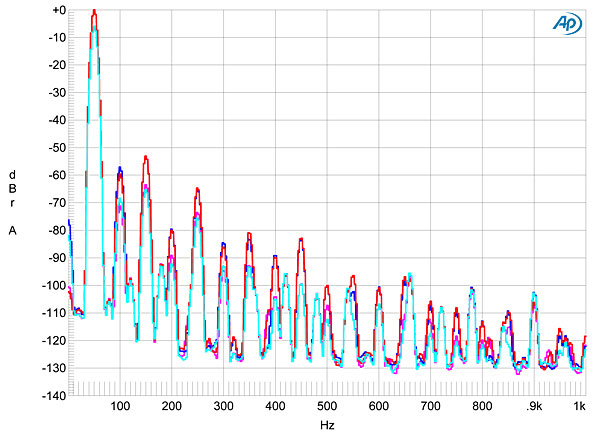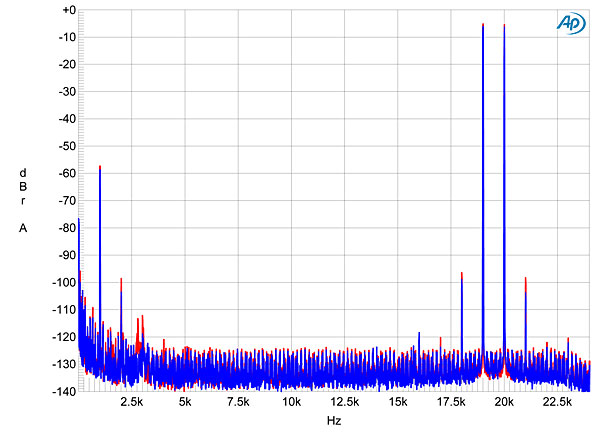| Columns Retired Columns & Blogs |
Ypsilon PST-100 Mk.II line preamplifier Measurements
Sidebar 3: Measurements
I primarily measured the Ypsilon PST-100 Mk.II using the Audio Precision SYS2722 system (see www.ap.com and "As We See It" in the January 2008 issue). The maximum volume-control setting in active mode was "37"; the control operated in 1dB steps from "37" to "34," in 1.5dB steps from "33" to "16," in 2dB steps from "15" to "11," and in 3dB steps below that level. In passive mode, the maximum setting was "31," but with the control steps following the pattern set in active mode. The voltage gain into 100k ohms in active mode was 11.1dB from balanced input to balanced output, but 17.1dB from unbalanced input to unbalanced output. In passive mode, the maximum gain was –0.03dB unbalanced but –6.03dB balanced. The 6dB difference between balanced and unbalanced operation in both active and passive modes suggests that the circuit is operating on only half the balanced signal; ie, just one of the signal phases. The PST-100 Mk.II preserved absolute polarity in passive mode for both balanced and unbalanced operation, but inverted polarity in active mode, which is to be expected from a gain stage using a single tube.
In active mode with the volume control at "37," the Ypsilon's input impedance was the same for balanced and unbalanced inputs, at 44k ohms at low and middle frequencies, this dropping slightly at 20kHz, to 20k ohms unbalanced and 38k ohms balanced. In passive mode, the input impedance varied with the volume control setting. Set to "31," the input impedance at low and high frequencies was 20k ohms, rising to 30k ohms at 1kHz; at "26," the input impedance was 25k ohms at low and high frequencies, and 36k ohms at 1kHz; and at "19," the impedance was 25k ohms at low and high frequencies, 43k ohms at 1kHz. The variation in input impedance should have no subjective consequences.
The PST-100's output impedance in passive mode was usefully low, but also varied with the volume-control setting and, to a lesser extent, with frequency. With the control set to "31," the output impedance was 21 ohms across the audioband; at "26," it was 44 ohms at 20Hz, rising to 48 ohms at 1kHz and 118 ohms at 20kHz; at "19," it was 13 ohms at low and middle frequencies, rising to 25 ohms at 20kHz. These variations will not have any audible effects. In active mode, the output impedance for both balanced and unbalanced operation was 560 ohms over most of the audioband, rising inconsequentially to 626 ohms at 20kHz.
The preamplifier's frequency response in passive mode was flat from 10Hz to 200kHz (fig.1, green and gray traces). In active mode, however, it varied with both the volume-control setting and the load impedance. The blue and red traces in fig.1 show the response into 100k ohms with the control at "29": a mild rolloff in the bass reaches –0.5dB at 20Hz, but severe peaks appear above the audioband. Reducing the load to 600 ohms knocks these peaks down (fig.1, cyan and magenta traces). They also change in height as the volume control is operated, but remain severe in nature. In themselves, however, these peaks should be inaudible.

Fig.1 Ypsilon PST-100 Mk.II, balanced frequency response at 1V into 100k ohms with volume control at "29" in active mode (left channel blue, right red), into 600 ohms in active mode (left cyan, right magenta), and in passive mode with volume control at "31" (left green, right gray). (0.5dB/vertical div.)
The Ypsilon's channel separation in active mode was good rather than great, at 90dB or so in both directions at 2kHz, decreasing to 72dB at the frequency extremes (not shown). Its unweighted, wideband signal/noise ratio in balanced active mode, with the input short-circuited but the volume control set to its maximum, was also good rather than great, at 72.6dB ref. 1V output. (The unbalanced figure was 12dB better.) Switching an A-weighting filter into circuit improved the balanced ratio to 84dB. As fig.2 shows, this is because the Ypsilon's noise floor in active mode includes spurious supply-related components, with the odd-order harmonics higher in level than the even-order harmonics. It's fair to note, however, that Michael Fremer didn't find this low-level problem audible —and in passive mode, the noise drops by 20dB.

Fig.2 Ypsilon PST-100 Mk.II, active mode, balanced spectrum of 1kHz sinewave, DC–1kHz, at 1V into 100k ohms (left channel blue, right red; linear frequency scale).
Fig.3 plots the percentage of total harmonic distortion plus noise in the PST-100 Mk.II's unbalanced output in active mode against output voltage. Despite using a single tube, the circuit is very linear into high impedances, the distortion not starting to rise above the noise floor until a few hundred millivolts output. The traces indicate that the Ypsilon is not happy driving low impedances, but even at the highest output level the preamplifier will be asked to deliver in practical use, 2V, into 10k ohms, the THD remains below 0.1%. The noise is higher in level with balanced operation, but the rise in distortion with output voltage is identical.

Fig.3 Ypsilon PST-100 Mk.II, active mode, unbalanced distortion (%) vs 1kHz output voltage into (from right to left at 1% THD): 100k, 10k, 3k, 1k ohms.
The use of transformers for the volume control does compromise the Ypsilon's THD at low frequencies, which can be seen in the blue and red traces in fig.4. Even though the distortion is respectably low between the upper bass and mid-treble at the 2V output level, the THD reaches 0.5% at 20Hz. The THD also rises at the top of the audioband and above, as well as into the punishing 600 ohm load (cyan and magenta traces). In active mode, the PST-100 should not be used into loads below 10k ohms.

Fig.4 Ypsilon PST-100 Mk.II, active mode, balanced THD+N (%) vs frequency at 2V into 100k ohms (left channel blue, right red) and 600 ohms (left cyan, right magenta).
The low-frequency distortion does drop rapidly with decreasing signal level. Fig.5 shows the spectrum of the Ypsilon's balanced active output while it drives 50Hz at 2V into 100k ohms (blue and red traces) and at 1V (cyan and magenta traces). Both spectra are dominated by odd-order harmonics, but while at 2V the 150Hz component reaches –54dB (0.6%), it drops to –60dB (0.1%) at 1V, with all other harmonics dropping by a proportional amount. With a 1kHz signal at 1V into 100k ohms (not shown), the only harmonic above –100dB that was visible in the spectrum was the third, at –66dB (0.05%). The PST-100 Mk.II in active mode also offered good performance on the demanding high-frequency intermodulation test (fig.6). Although the second-order difference product rose slightly above the –60dB line, all the higher-order products are very low in level.

Fig.5 Ypsilon PST-100 Mk.II, active mode, balanced spectrum of 50Hz sinewave, DC–10kHz, at 2V into 100k ohms (left channel blue, right red), and at 1V into 100k ohms (left cyan, right magenta; linear frequency scale).

Fig.6 Ypsilon PST-100 Mk.II, active mode, balanced HF intermodulation spectrum, DC–30kHz, 19+20kHz at 2V into 100k ohms (left channel blue, right red; linear frequency scale).
The Ypsilon PST-100 Mk.II offered excellent performance in passive mode, with minimal insertion loss in unbalanced mode, and its transformer-based design suffered very little changes in its operating conditions due to the impedances of the components both upstream and downstream of it. Its active mode was more problematic; while most of the measured problems in active mode will be below the threshold of audibility under normal conditions, I wasn't surprised that MF preferred the preamp's sound in passive mode. Balanced operation had higher noise than unbalanced, which suggests that this mode of operation is offered as a convenience, the PST-100's volume-control transformer and active circuitry operating in single-ended fashion.—John Atkinson
- Log in or register to post comments




































